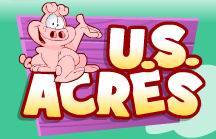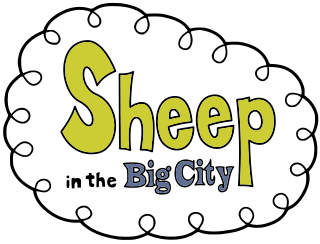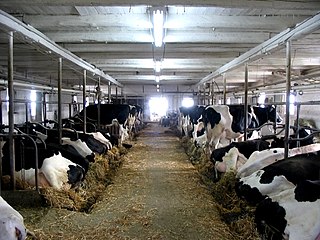Related Research Articles

Animal husbandry is the branch of agriculture concerned with animals that are raised for meat, fibre, milk, or other products. It includes day-to-day care, management, production, nutrition, selective breeding, and the raising of livestock. Husbandry has a long history, starting with the Neolithic Revolution when animals were first domesticated, from around 13,000 BC onwards, predating farming of the first crops. During the period of ancient societies like ancient Egypt, cattle, sheep, goats, and pigs were being raised on farms.

U.S. Acres is an American comic strip that ran in newspapers from 1986 to 1989, created by Jim Davis, author of the comic strip Garfield.

Sheep in the Big City is an American animated television series created by Mo Willems for Cartoon Network. The 9th of the network's Cartoon Cartoons, the series' pilot first premiered as part of Cartoon Network's "Cartoon Cartoon Summer" on August 18, 2000, before its official debut on November 17, 2000. It aired until April 7, 2002, with repeats airing until 2003.

Harvest Moon 2 GBC, released in Japan as Bokujō Monogatari GB2 (牧場物語GB2), is a farm simulation video game for the Game Boy Color developed and published by Victor Interactive Software, and the second portable game in the Story of Seasons series. The object of the game is to cultivate a farm to prevent the land from being used to build an amusement park. As with the previous game, the player may choose to play as a boy or a girl.
A sheep–goat hybrid is a hybrid between a sheep and a goat.

Horton the Elephant is a fictional character from the 1940 book Horton Hatches the Egg and 1954 book Horton Hears a Who!, both by Dr. Seuss. He is also featured in the short story Horton and the Kwuggerbug, first published for Redbook in 1951 and later rediscovered by Charles D. Cohen and published in the 2014 anthology Horton and the Kwuggerbug and More Lost Stories. In all books and other media, Horton is characterized as a kind, sweet-natured, and naïve elephant who manages to overcome hardships.

Poultry farming is the form of animal husbandry which raises domesticated birds such as chickens, ducks, turkeys and geese to produce meat or eggs for food. Poultry – mostly chickens – are farmed in great numbers. More than 60 billion chickens are killed for consumption annually. Chickens raised for eggs are known as layers, while chickens raised for meat are called broilers.

Many farmers in India depend on animal husbandry for their livelihood. In addition to supplying milk, meat, eggs, wool, their castings (dung) and hides, animals, mainly bullocks, are the major source of power for both farmers and dairies. Thus, animal husbandry plays an important role in the rural economy. The gross value of output from this sector was 8,123 billion Rupees in FY 2015–16.
The House of Tomorrow is a 1949 animated theatrical short directed by Tex Avery. It was part of a series of cartoons Avery did satirizing technology of the future which included: The Car of Tomorrow, The T.V. of Tomorrow, and The Farm of Tomorrow. These were spoofs of live-action promotional films that were commonly shown in theaters at the time.

A Broken Leghorn is a 1959 Warner Bros. Looney Tunes cartoon short directed by Robert McKimson. The cartoon was released on September 26, 1959, and features Foghorn Leghorn and Miss Prissy. The voices are performed by Mel Blanc.
The Ugly Duckling is an animated black-and-white cartoon released by Walt Disney in 1931 as part of the Silly Symphonies series. This cartoon was later remade into a color version released in 1939, which follows the original Andersen story much more faithfully. This gives The Ugly Duckling the unique distinction of being the only Silly Symphony to be made twice. This film was then sold to reach about 4,000 dollars per month at the most profit, because it slowly climbed up the scale of growth.

Poultry farming is a part of the United States's agricultural economy.
Fowl Weather is a 1953 Warner Bros. Merrie Melodies animated short directed by Friz Freleng. The short was released on April 4, 1953, and stars Tweety and Sylvester.

Dairy farming is one of the largest agricultural sectors in Canada. Dairy has a significant presence in all of the provinces and is one of the top two agricultural commodities in seven out of ten provinces.
The Kuroiler is a hybrid breed of chicken developed by the Keggfarms Group in Gurgaon, Haryana. Kuroilers are derived from crossing either coloured broiler males with Rhode Island Red females, or, White Leghorn males crossed with female Rhode Island Reds.

Agriculture played a major role in the early growth of Connecticut as one of the original 13 colonies that would form the United States of America, particularly in the Connecticut River valley which provides fertile soil, temperate climate and easy access to markets. As the Industrial Revolution helped focus capital on mercantile centers in the 19th century, Connecticut farmers over time ceded their relative economic and political influence.

Chick sexing is the method of distinguishing the sex of chickens and other hatchlings, usually by a trained person called a chick sexer or chicken sexer. Chicken sexing is practiced mostly by large commercial hatcheries to separate female chicks or "pullets" from the males or "cockerels". The females and a limited number of males kept for meat production are then put on different feeding programs appropriate for their commercial roles.

The broiler industry is the process by which broiler chickens are reared and prepared for meat consumption. Worldwide, in 2005 production was 71,851,000 tonnes. From 1985 to 2005, the broiler industry grew by 158%.

Connie the Cow is a children's television series created by Josep Viciana, and designed by Roman Rybakiewicz. It was produced by Spain-based studio Neptuno Films, and it aired on TV3 in Catalonia. In the United States, it aired on Noggin.
The Chicken of Tomorrow Contest was an animal husbandry contest held between 1946 and 1948 and sponsored by the American grocery store chain A&P, in partnership with the US Department of Agriculture (USDA), to encourage the development of broiler chickens breeds with more meat. Most broiler chickens around the world descend from the contest such as the Cobb 500.
References
- ↑ "AVERY…. Vol. 2??? WELL, IMAGINE THAT! -". cartoonresearch.com. December 7, 2020. Retrieved December 15, 2020.
- ↑ Lenburg, Jeff (1999). The Encyclopedia of Animated Cartoons. Checkmark Books. pp. 146–147. ISBN 0-8160-3831-7.